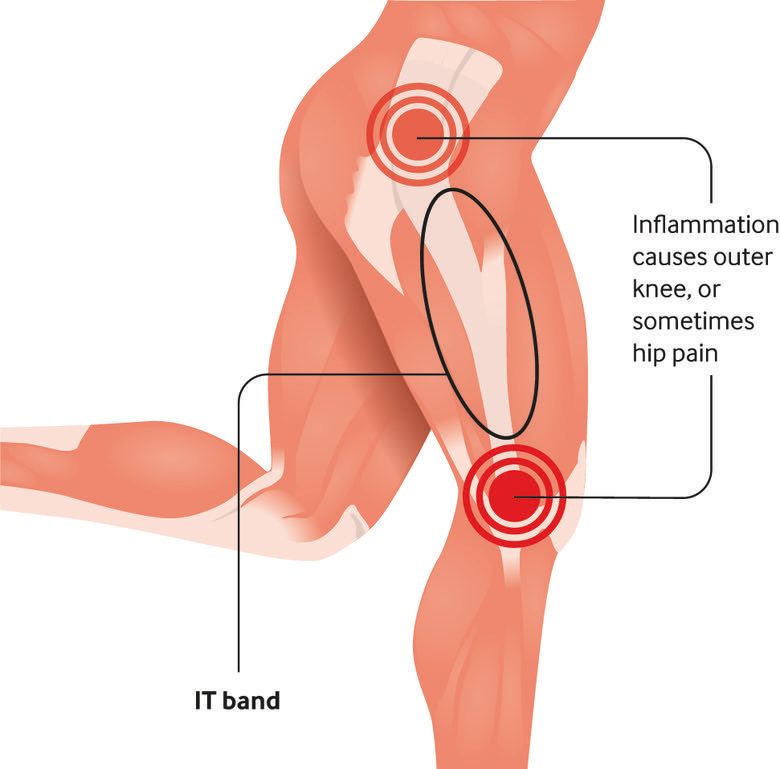Although running and cycling are the most common activities to cause iliotibial band syndrome or ITB syndrome, it is possible to get the condition from participating in other sports as well, such as tennis or football. ITB syndrome is an overuse ailment, meaning that it tends to get worse when you do the same movement repeatedly. The more of it you do over a week, the greater your chances of getting it. There are components of your body that, when present, can increase your risk of developing ITB syndrome. Those components include having weak muscles in your knees, tightness in your TB band, and tiny changes in the length of your legs are all examples of these types of conditions.
Causes of ITB Syndrome
Here are some of the main factors that causes IT Band Syndrome:
1. Fast Training
It is not always healthy for the joints to follow a rigorous exercise plan. Athletes are instructed to gradually increase the duration and intensity of their workouts over several weeks or months to reduce their risk of ITB syndrome and other ailments.
2. Cycling
Although runners and cyclists are particularly at risk for IT band pain, any athlete who participates in activities that involve repetitive knee motion is at risk for developing the condition. Other types of athletes at risk for developing ITB syndrome include those who participate in speed walking, basketball, or soccer, and weightlifting.
Iliotibial Band Syndrome and Cycling
3. Lack of Flexibility
If the hip adductors, which are the muscles on the inside of the thigh, are weak, the IT band can become tight. In the same way, if the hamstrings or other muscles in the thighs are too tight, the IT band may also tighten.
4. Avoiding warm-up
While it may be tempting to get immediately into a workout, your muscles and soft tissue will be better served by performing some light exercise for five to ten minutes before progressing to more strenuous action.
5. Footwear
The form in which the foot strikes the ground can affect not only the joints of the foot and ankle but also the joints of the knee and the hip, as well as the muscles and other connective tissues that support those joints. The use of appropriate footwear can enhance biomechanics, which in turn can lessen or prevent pain in the IT band.
Also Read: Knee Replacement
 IT Band Syndrome
IT Band SyndromeDiagnosis of IT Band Syndrome
Your healthcare professional will start by gathering your medical history. In addition to asking about your current symptoms, they will inquire about your other health conditions. The physician will conduct a physical examination, including a thorough analysis of your knee. This will include assessments of your knee's range of motion, stability, and painful areas. Your healthcare professional will need to differentiate between ITB syndrome and other probable knee pain causes. Among these include osteoarthritis and meniscal tears.
Typically, your doctor will not require any extra testing to identify ITB syndrome. If the diagnosis is ambiguous, imaging procedures such as an X-ray or MRI may be required to rule out other potential causes.
Treatments of ITB Syndrome
After knowing the main causes of IT Band syndrome, know the treatment of ITB Syndrome:
- Your hip and knee discomfort can be alleviated via the use of stretches, strengthening exercises, and other therapies that can be offered to you by a physical therapist. These therapies may assist you in lengthening your iliotibial band, which will result in a reduction in the amount of strain. A physical therapist can also instruct you on the most effective ways to prepare your body for exercise by warming it up first and then cooling it down afterward.
- Most of the doctors in this situation suggest the patients take a rest. They also advise that they should refrain from exercising the leg that is injured until both the pain and the ITB syndrome have entirely healed. Have a discussion with your healthcare professional about the appropriate rest and activity levels for you.
- At-home treatments for pain and inflammation might include activities such as stretching, massage, and the application of foam rollers to the affected area.
- The IT band's majority issues are due to a lack of strength in the glutes and hip area. It is essential to make improvements in these areas. The weak spots can be targeted with a series of strength exercises, such as the ITB Rehab Routine, which will allow you to go back to running sooner. Even while core exercises do not immediately affect your IT band, it is still a good idea to perform them. If you take a break from jogging for a while, you'll have more time to work on strengthening your core.
Prevention from ITB Syndrome
The best way to avoid ITB syndrome is to fix any personal factors or training habits that can lead to lousy biomechanics. A complete exercise program includes staying hydrated, being flexible, and strong, and controlling the pelvis, hips, knees, foot, and ankle. It also makes sure that the training environment is suitable to reduce the amount of stress on the knees. Before starting a new training or rehabilitation program, you should talk to a health and fitness professional.
Conclusion
If you decrease the amount of activity you do, stretch, and take an NSAID, your ITB syndrome may worsen. It is essential to discover the reasons behind this pain to forestall it from occurring again in the future. If the pain in your IT band does not go away, you should discuss alternate treatment options with your primary care physician as soon as possible.
Frequently asked questions
Q. How much time does it take to heal from ITB syndrome?
A. It generally takes 6 to 12 weeks to heal.
Q. Is ITB syndrome dangerous?
A. It is not very dangerous because the treatments are readily available.
Also Read: Know About Chronic Fatigue Syndrome

